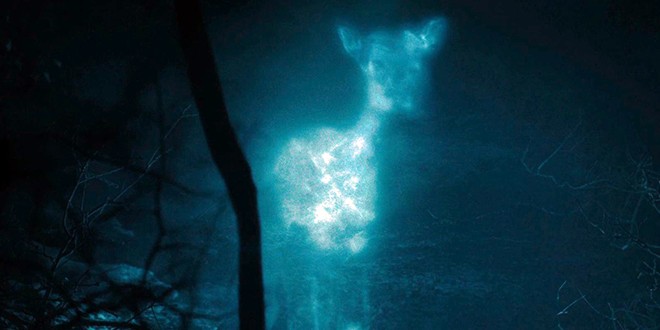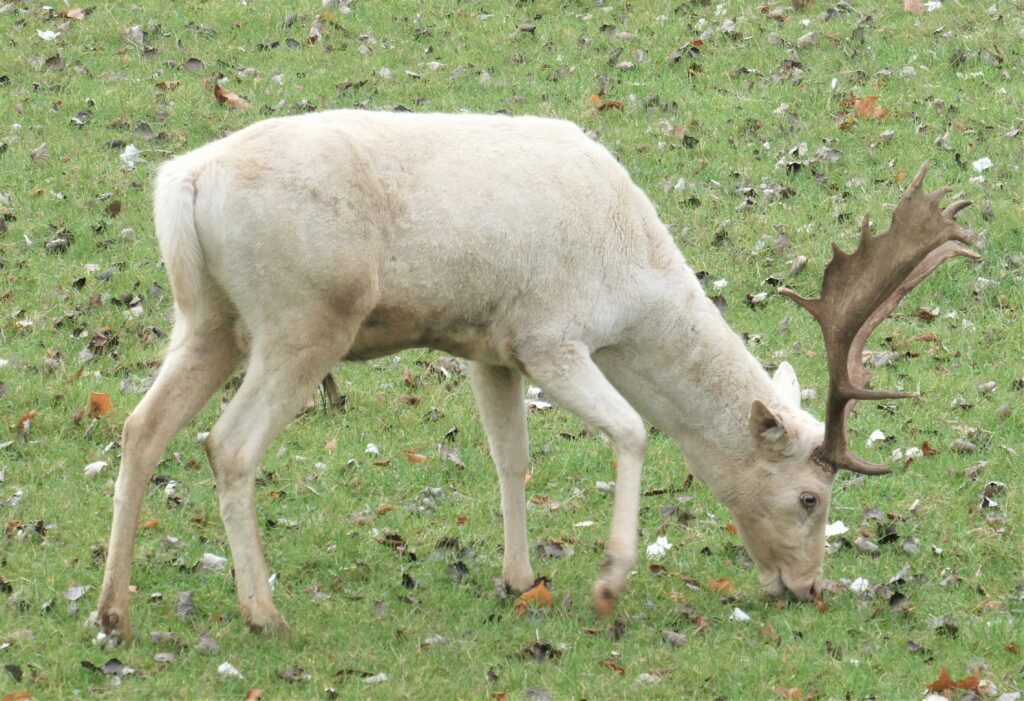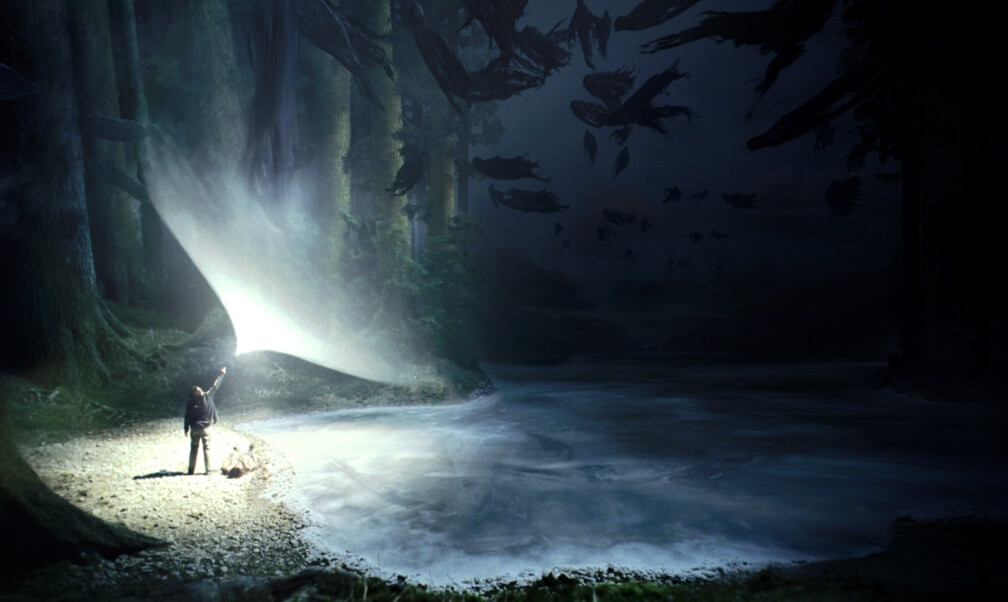Christmas in the Forest of Dean: The Silver Doe – Part 2
by Dr. Beatrice Groves
What was it, Harry asked himself (walking again), that Dumbledore had told him the last time he had retrieved the sword? Only a true Gryffindor could have pulled that out of the Hat. And what were the qualities that defined a Gryffindor? A small voice inside Harry’s head answered him: their daring, nerve and chivalry set Gryffindors apart.” (DH 368)
The knightly aspect of Harry’s quest to regain the Sword of Gryffindor in Harry Potter and the Deathly Hallows is made clear from the reappearance of the word “chivalry” as he ponders how to take the sword from the pool. This is, in fact, the only other time the word appears in Harry Potter after the Sorting Hat’s opening song (which Harry is quoting from here). The chivalric nature of this moment – with its close parallel to Excalibur coming to Arthur from the lake – is likewise stressed when Dumbledore tells Snape that Harry must take the sword “under conditions of need and valor” (DH 689). But there is another, less recognized, Arthurian aspect to this scene – the messenger who comes to take Harry to the sword: “a silver-white doe, moon-bright and dazzling” (DH 366).

The hunt of the white stag is a recurring motif in Arthurian literature, a regular opening gambit – “which can form a prelude to almost any kind of magical adventure “1 – in which the knightly chase leads the hero away from the safety of their friends and out on to a quest. In these stories, the hero leaves his friends far behind, as he follows the white deer deeper into the forest – an idea closely echoed in Deathly Hallows as Harry, too, follows the marvelous white deer deeper into the forest, alone: “he knew, he would have staked his life on it, that she had come for him, and him alone” (DH 366). In the literary hunts of medieval literature, the pursued animal acts “as a lure, a guide, or psychopomp to draw the hunter ineluctably on his course from known surroundings into an unfamiliar, unsuspected, or forbidden territory where a crucial contest would take place, one that would change his life” and, as a sign of this transformation, “this pursued animal often had uncanny qualities – whiteness for instance.” 2

This picture of a white stag was taken in Oxford by Dr. Beatrice Groves.
Arthur’s hunt after the white stag was famously used by C.S. Lewis in The Lion, the Witch and the Wardrobe, in which the young royals hunt this white stag at the end of the novel, only to find it takes them back out of Narnia. Lewis’s use of a stag (rather than a doe or a boar) accurately reflects the literature in which Arthur most frequently sets off in pursuit of a white stag. But it has also served to color modern preconceptions about that literature, for it is one reason that it is relatively unknown that in many medieval stories, the knights chase a white doe rather than a stag.
Rowling studied French at University, and it is possible, therefore, that she studied the famous “lais” of Marie de France. Breton lais are traditional, orally transmitted songs that Marie de France (writing in French, probably at the English court, in the twelfth century) transformed into narrative poems. In one of these – Guigemar – the adventure begins with a white doe. The eponymous Breton knight Guigemar foreswears all love, but one day he becomes separated from his friends on a hunt and finds “a hind, completely white.” 3 Guigemar mortally wounds this magical white doe, and as a result, his life – and his attitude to love – changes forever.
In another Breton lai, the thirteenth-century Graelent, the hero pursues a fairy-like deer – “a completely white doe,/ whiter than the snow that lies on the branch” – to a woodland fountain.4 There he meets his fate in the form of a beautiful fairy, who is bathing in the fountain – for here, as in many medieval poems, the forest fountain is an enchanted place (an idea Rowling also draws on in her story “The Fountain of Fair Fortune” in The Tales of Beedle the Bard). In other medieval versions of the Graelent story – such as the story of Wayland the smith and le Chevalier au Cygne – the hero likewise becomes separated from his friends as he follows a white doe to a fountain, although in these versions, the beautiful women he finds bathing there are swan-maidens.
In at least four medieval stories, therefore, the pursuit of the white stag transforms into a pursuit of a white doe – perhaps an intentional marker of the love stories that will follow.

Such stories of hunts after white deer – whether hart or hind – are common to Welsh, Irish, and Breton tales, and it has been argued that their whiteness is a specifically Celtic motif, a sign of a messenger from the Otherworld: “a magic white animal (doe, hart, or boar) which still retains traces of its origin as a transformed fairy, and which occurs as a preliminary to an Otherworld visit.” 5 In Welsh stories, in particular, white animals are a sign of messengers from “the Otherworld,” and in both Welsh and Irish traditions, deer are among are the most important of such messengers.8 Harry’s silver-white doe, therefore, has powerful links with Celtic symbols of messengers from the Otherworld and Arthurian quests, but it also has another layer of mythic (and religious) significance.
Hungarian poetry, one of the literary cultures, which has taken the image of the white stag most deeply to heart, melds these ideas together in a seamless tradition:
The great Oriental King, Nimrod, had two sons, Hunor and Magor. They went hunting one day and saw a creature that was snow white and had golden antlers – it was both female and male, ‘hind’ and ‘stag.’ It lured them farther and farther to the West, where the hunting grounds were richer and the land more fertile… The ‘Miracle Stag’ thus led the Magyars to present-day Hungary where they arrived in the year 896… In the year 1000 Saint Stephen… converted the Hungarians to Christianity. Then once again the ‘Miracle Stag’ appeared. It had burning candles on the tips of its antlers – it was, in fact, a living cathedral and the very messenger of the Virgin Mary and of Jesus Christ himself.”7
In the Hungarian myth of the “Miracle Stag,” the white stag/hind encompasses both male and female, and both Christian and pre-Christian myth.
The uncanny whiteness of Otherworld animals, such as the “Miracle Stag,” of course, has survived in two of its most famous literary rewritings: the White Whale hunted in Moby Dick and the White Rabbit, whom Alice follows only to fall down the rabbit hole and find Wonderland.8 Most clearly, the Arthurian white stag lies behind the white stag in The Lion, the Witch and the Wardrobe, who will answer the wishes of those who catch him. This “milk-white Stag” forms one of the circles of the novel, for Mr. Tumnus tells Lucy of him in the second chapter of The Lion, the Witch and the Wardrobe, and then, at the very end of the story, Mr. Tumnus “brought them the news that the White Stag had once more appeared in his parts – the White Stag who would give you wishes if you caught him” (ch. 17). Both the Narnian White Stag who grants wishes and the medieval Otherworld white doe messenger (in both the Story of Wayland and Guigemar the white doe speaks to the hero) appear to inform Harry’s expectations of his silver-white doe: he believes he will catch up with her “and then she would speak, and the voice would tell him what he needed to know” (DH 366).
The Stag as a Christian Symbol
Harry sees the silver-white doe during Christmastide, and one reason for her appearance at this sacred time of year is that stags in general, and white stags in particular, have long been symbols of Christ. Sometimes this is linked to the animal’s supposed antipathy to serpents (it seems suitable in this regard that the two Gryffindors with a stag Patronus – Harry and his father – should have such animosity towards Slytherins). This serpent-slaying stag is familiar from bestiaries, and in some cases, such as the Bestiaire Divin of Guillaume Ie Clerc, this becomes an explicitly Christic image: “the stag is Christ harrowing hell and overcoming the serpent, Satan.” 9

In Arthurian stories, likewise, this stag once becomes an explicit symbol of Christ. In Malory, the grail quest transforms the knightly quests of his earlier stories into something more rarefied – and so it is with the white stag in Sankgreal. This stag is no longer the quarry of a hunt, but he still leads the knights to new pastures. Sir Bors, Sir Percival, and Sir Galahad see a white hart led by four lions, and they follow and watch as the animals enter a chapel. The knights look on as – while the priest says mass – the hart transforms into a man on the altar, enthroned by the lions who transform into the figures of the four Evangelists. When the knights tell the priest of their vision, he explains:
And well ought Oure Lorde be signifyed to an harte. For the harte, whan he ys olde, he waxith yonge agayne in his whyght skynne. Right so commyth agayne oure Lorde frome deth to lyff, for He lost erthely fleysshe, that was the dedly fleyssh which He had takyn in the wombe of the Blyssed Virgyne Mary. And for that cause appered oure Lorde as a whyghte harte withoute spot.” (590.1-7)10
In Malory, both the whiteness of the stag and its capacity for renewal makes it a symbol for Christ’s immortal flesh. The (often sexualized) imagery of the hunt from earlier Arthurian stories has gone, but in a more profound way, following the white hart has led the knights to their heart’s desire, taking them closer to the Holy Grail and to an understanding of its spiritual meaning.
The Forest Again
This blog started because I wanted to follow my own sense of Arthurian depths of the Christmastide appearance of the silver-white doe in the Forest of Dean. And I discovered, even more than I had expected, that white harts (and hinds) are integral to Arthurian quests. But I also discovered something I did not expect – a little Christmas present waiting for me in the sources.
Like most English people, I am woefully ignorant of The Mabinogion, a collection of Middle Welsh prose stories including perhaps one of the earliest Arthurian texts, Culhwch and Olwen. I suspect, however, that Rowling might be rather better informed than most English people about The Mabinogion, given that she was brought up and educated so close to Wales. So, upon discovering that Arthur quests after a white stag in some of its tales, I settled down to read the story of Geraint – only to find it beginning precisely where I had begun. The story starts with Arthur holding court at Caerleon when a tall, fair-hair youth approaches the king:
I am one of thy foresters, Lord, in the Forest of Dean… In the Forest I saw a stag, the like of which beheld I never yet… He is of pure white, Lord, and he does not herd with any other animal through stateliness and pride, so royal is his bearing.”11
Harry’s silver-white doe turns out to be a perfectly Arthurian beast in location as well as color. She is a deer of Otherworld whiteness who leads the hero away through the forest on an adventure meant only for him, just as in so many other medieval tales. But not only this – even the forest through which she leads him is the right one. Harry, like Arthur in The Mabinogion, is led out on a quest by a white deer through the Forest of Dean.
Wishing you all a very happy Christmas.
1 Rachel Bromwich, “Celtic dynastic themes and the Breton Lays,” Études celtiques 9.2 (1961): 439-74 (444).
2 Marcelle Thiébaux, The Stag of Love: The Chase in Medieval Literature (Ithaca, New York: Cornell University Press, 2014), 56.
3 The Lays of Marie de France, trans. David R. Slavitt (Edmonton: AU Press, Athabasca University, 2013), 7.
4Graelent ll.209-212 in The Lays of Desiré, Graelent and Melion: Edition of the Texts with an Introduction, ed. E. Margaret Grimes (New York: Institute of French Studies, 1928), 83.
5Bromwich, “Celtic dynastic themes,” 463. See also: Thiébaux, The Stag of Love, 199.
6Roger Sherman Loomis, Arthurian Tradition and Chrétien De Troyes (Columbia University Press, 1949), 68; Miranda Green, Animals in Celtic Life and Myth (Routledge, 2002), 166-167.
7Adam Makkai, ed. In Quest of the ‘Miracle Stag:’ The Poetry of Hungary (Chicago: Atlantis-Centaur, 1996), xiii.
8Thiébaux, The Stag of Love, 56.
9Thiébaux, The Stag of Love, 41-42.
10Thomas Malory, Malory: Works, ed. Eugène Vinaver, Second Edition (Oxford: Oxford University Press, 1971)
11The Mabinogion, trans. Charlotte Guest (London: Bernard Quaritch, 1877), 142.
Dr. Beatrice Groves teaches Renaissance English at Trinity College, Oxford, and is the author of Literary Allusion in Harry Potter, which is available now. Don’t miss her earlier posts for MuggleNet – such as “Solve et Coagula: Part 1 – Rowling’s Alchemical Tattoo” – all of which can be found at Bathilda’s Notebook. She is also a regular contributor to the MuggleNet podcast Potterversity.

